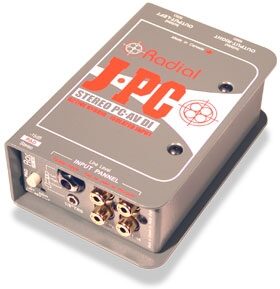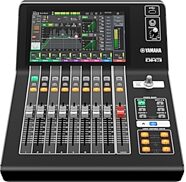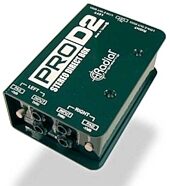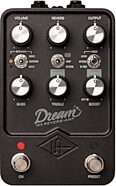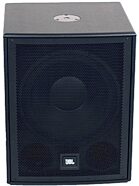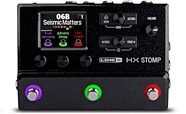Radial JPC Stereo PC AV Direct Box
No longer available at zZounds



Engineered for professional sound systems, this Radial DI box has two 48V phantom powered channels, an active drive circuit and transformer-isolated inputs.
Overview
A two-channel hybrid direct box designed to address the demand for interfacing computer sound cards, consumer electronics and other gear to professional sound systems. The JPC features two active 48V phantom powered channels in a compact, rugged enclosure. The JPC combines an active drive circuit, for long cable runs, with transformer isolated inputs to eliminate hum and buzz caused by ground loops. Multiple input and thru connectors for great versatility include 1/8 in. stereo, 1/4 in. stereo and RCA.
- Transformer isolation eliminates ground loops
- Converts -10db to balanced XLR mic level
- Active drive circuit for long cable runs
- Compact design -- may be J-Rak mounted
- 48V phantom power eliminates batteries
- Ultra-rugged 14-gauge steel construction
The Radial JPC is a stereo direct box that has been specifically designed for use with computer sound cards and other consumer electronic products to allow these to be connected to a professional sound system. It is unique in that it combines the advantages of transformer-isolated inputs with an active drive circuit, giving you the 'best of both worlds' in a compact and extremely flexible package.
Transformer coupled inputs have the unique advantage of isolating the 'source' from the 'destination'. This proven approach eliminates 60-cycle hum and buzz caused by so-called ground loops when two pieces of electrically powered devices are connected together. Because the… read more active circuit does all of the impedance conversion and balancing, a dedicated 1:1 transformer can be used. This results in a hybrid design that is at once great sounding, compact and more affordable.
As with all great designs, simplicity is a fundamental trait and the Radial JPC certainly fits the bill. A choice of stereo 1/4 in., 1/8 in. and RCA input AND thru-put connectors make interfacing a snap with all types of equipment. A single switch inserts a -10dB pad, two power LEDs confirm 48V phantom is turned on, and a pair of XLR output connectors round out the feature set.
Of course like all Radial products, the JPC is built to handle any environment. The book-cover wrap-around sleeve design protects switches and connectors from damage while the 14 gauge steel I-beam construction eliminates stress that could torque the PC board and cause solder joint failure. A full-bottom no-slip pad provides electrical insulation and mechanical isolation with plenty of 'stay-put' for use on hectic stages. And with its baked enamel finish, the Radial JPC will continue looking great for years.
JPC Development & Evolution
As with most clever products, necessity is the mother of invention -- The Radial JPC is no exception. In this case it was the demand from recording engineers out there for a useful and simple solution to allow them to take full advantage of the power of innovative technologies like computers, media players and recorders, integrating them into their productions. With this integration comes the many challenges of physically connecting disparate consumer grade devices to the world of professional audio. This obvious need spawned the development of the Radial JPC.
The challenge of a Computer interface
For the audio engineer, interfacing computers and video equipment to a professional audio system involves dealing with connectors, signal levels and integrity: For the most part, consumer level products are outfitted with less than ideal connectors, are generally unbalanced and are notorious for causing system noise.
For instance the audio output connection from a computer sound card or Laptop is typically a 1/8 in. mini TRS (3.5mm) connector while audio from a DVD/CD player is generally an RCA connector. These high impedance sources must be converted to a balanced mic level in order to work along side microphones in snake systems, mic splitting transformers and consoles. The Radial JPC is outfitted with 1/8 in. TRS stereo input, twin RCA jacks and sports a stereo 1/4 in. TRS jack to make this easy. To help address the various output levels, a -10dB input pad ads flexibility while reducing opportunity for overload which of course will cause distortion.
To further enhance functionality, all of the input connectors are designed to act as thru-puts allowing the signal from a given source to not only pass through the JPC to the XLR balanced output, but allows the system engineer to drive a secondary mixer or recorder at the same time. This would typically be used for personal monitoring, for recording a performance, to drive a second speaker system or possibly an assistive listening system.
The JPC's 'active hybrid' design
Probably the single most troublesome aspect to system design is eliminating noise caused by so-called ground loops. Most consumer electronic products are designed to work on their own and as such, do not incorporate extra 'problem solvers' in their circuit design. You connect the computer to the sound card, the sound card to some battery operated speakers and voila; it all works fine. The trouble of course starts when you connect the computer to the sound system and all of a sudden, you get that dreaded 60-cycle hum. This 'noise' is caused by stray voltage and the resulting common mode noise as the two devices are connected together. The solution: Transformer isolation.
Although the Radial JPC is an active direct box, the input connections are 100% transformer isolated giving rise to its 'hybrid' designation. These isolated inputs reduce noise while the active drive circuit performs the impedance conversion and balancing allowing long cable runs. This 'best of both worlds' solution makes hook-up noise-free, reduces input circuit loading and gives you great sound.
Why balancing in the first place?
Balanced circuits first appeared with the proliferation of the telephone some 100 years ago. It was found that when a signal is transmitted over a balanced low-impedance twisted pair of wire, noise was significantly reduced when driving long distances. This basic phase-canceling technology has remained unchanged and is the foundation for all balanced professional audio-interconnect equipment today.
There are many reasons for converting hi-impedance signals to low-impedance balanced circuits: First and foremost, it allows long cable runs without appreciable noise. Proper impedance and level matching not only improves sound quality, it also is critical when interfacing with snake systems that are outfitted with splitters. Splitters employ mic bridging transformers. These are designed to work with 600-Ohm microphone levels, which would otherwise be saturated with higher signal levels. Furthermore, since signals from microphones are usually running along side the output from direct boxes, excessive levels can cause crosstalk or induced noise from the higher output device. The Radial JPC automatically converts these signals to balanced mic levels, solving the problem.
The 48V Phantom Power advantage
The Radial JPC is 48-Volt phantom powered. This means that it derives its power source from a DC voltage supplied from the mixing console through the XLR cable as opposed to using batteries or a local power supply. Phantom powering makes hook-up easy and worry free. Simply connect, turn the phantom power on at the console* and you are ready to go.
* Always ensure that the volume levels are turned down to zero before turning on phantom power. This will ensure the turn on transient does not harm your speakers or sound system.
Getting down to size
Another major concern for the field technician is keeping size to a minimum. What is the point of using a laptop computer only to have the interface double its size? As a tool, the JPC is compact enough to fit in a toolbox making it easy to carry anywhere and quick to deploy. The compact size also makes it easy to place adjacent to laptop computers and can be stored in computer bags for easy transport. Because of the JPC's exceptional I-beam construction and protective bookend design, worry-free transportation means the JPC will not let you down and the show will go on.
Functions
The JPC offers a myriad of input connector options to simplify interfacing your computer, DVD/CD, MP3 player or other consumer audio device with the world of AES standard professional ballanced equipment. As with all Radial products, only the highest professional standards are used inside and out, in circuitry and construction.
Inside the JPC
1. Isolated XLR connectors to eliminate chassis ground potential.
2. Active balanced circuit drives long cable runs without signal loss.
3. Audio Transformers on both inputs provide 100% isolation to eliminate hum and noise causing ground loops.
4. 14-Gauge steel welded I-beam construction makes it impossible to torque the PC board.
5. High grade switches -- long life, high cycle for reliable performance.
6. Military spec PC board with full surface ground plane to reduce RF noise susceptibility.
Input and Output Panels
7. -10dB pad reduces the level going into the JPC from loud sources that could overload the circuit and cause distortion.
8. 48V Power on LEDs lets you know that phantom has been turned on and is powering the two channels.
9. 1/4 in. TRS connector that will also work with 1/4 in. mono instrument signals.
10. 1/8 in. TRS connector designed for PCs and laptops, makes connection easy with standard 1/8 in. to 1/8 in. cable.
11. Twin RCA connectors are great for connecting DVD/CD players and video machines. RCA thru-puts for flexibility.
12. Book-end design creates a protective zone around the switches & connectors - Indestructable 14-gauge steel construction.
13. Twin balanced XLR male output connectors; AES standard with Pin-1 ground and Pin-2 hot.
14. Full no-slip rubber bottom pad provides mechanical isolation, electrical insulation and 'stay-put-ability.'
15. Heavy-duty baked enamel finish for excellent durability and great looks for years.
16. Side mounted ground-lift disconnects the ground path to the transformer at the XLR output. This is used when a ground path is made at the input side such as with a computer or rack module.
Construction
The JPC is designed to withstand the rigors of high-use professional environments. Radial's innovative book-end design provides a protective zone around the switches and connectors that makes it practically impossible to damage these components.
Stress on circuit boards causes broken and intermittant solder joints and is a common cause of failure in lesser DI's. Radial's 14-gauge welded I-beam inner chassis and 14-guage outer shell greatly reduce the possibility of torque stress being applied to the PC board.
A full-bottom no-slip rubber pad works double duty by (a) providing protection from electrical shock from (eg:) guitar amp handles which are often directly coupled to the amp chassis, and (b) assuring that the J48 won't slip and slide around. read less
Features
- Stereo DI for computer sound cards & A/V- Transformer isolation eliminates ground loops
- Converts -10db to balanced XLR mic level
- Active drive circuit for long cable runs
- Compact design -- may be J-Rak mounted
- 48V phantom power eliminates batteries
- Ultra-rugged 14-gauge steel construction
The Radial JPC is a stereo direct box that has been specifically designed for use with computer sound cards and other consumer electronic products to allow these to be connected to a professional sound system. It is unique in that it combines the advantages of transformer-isolated inputs with an active drive circuit, giving you the 'best of both worlds' in a compact and extremely flexible package.
Transformer coupled inputs have the unique advantage of isolating the 'source' from the 'destination'. This proven approach eliminates 60-cycle hum and buzz caused by so-called ground loops when two pieces of electrically powered devices are connected together. Because the… read more active circuit does all of the impedance conversion and balancing, a dedicated 1:1 transformer can be used. This results in a hybrid design that is at once great sounding, compact and more affordable.
As with all great designs, simplicity is a fundamental trait and the Radial JPC certainly fits the bill. A choice of stereo 1/4 in., 1/8 in. and RCA input AND thru-put connectors make interfacing a snap with all types of equipment. A single switch inserts a -10dB pad, two power LEDs confirm 48V phantom is turned on, and a pair of XLR output connectors round out the feature set.
Of course like all Radial products, the JPC is built to handle any environment. The book-cover wrap-around sleeve design protects switches and connectors from damage while the 14 gauge steel I-beam construction eliminates stress that could torque the PC board and cause solder joint failure. A full-bottom no-slip pad provides electrical insulation and mechanical isolation with plenty of 'stay-put' for use on hectic stages. And with its baked enamel finish, the Radial JPC will continue looking great for years.
JPC Development & Evolution
As with most clever products, necessity is the mother of invention -- The Radial JPC is no exception. In this case it was the demand from recording engineers out there for a useful and simple solution to allow them to take full advantage of the power of innovative technologies like computers, media players and recorders, integrating them into their productions. With this integration comes the many challenges of physically connecting disparate consumer grade devices to the world of professional audio. This obvious need spawned the development of the Radial JPC.
The challenge of a Computer interface
For the audio engineer, interfacing computers and video equipment to a professional audio system involves dealing with connectors, signal levels and integrity: For the most part, consumer level products are outfitted with less than ideal connectors, are generally unbalanced and are notorious for causing system noise.
For instance the audio output connection from a computer sound card or Laptop is typically a 1/8 in. mini TRS (3.5mm) connector while audio from a DVD/CD player is generally an RCA connector. These high impedance sources must be converted to a balanced mic level in order to work along side microphones in snake systems, mic splitting transformers and consoles. The Radial JPC is outfitted with 1/8 in. TRS stereo input, twin RCA jacks and sports a stereo 1/4 in. TRS jack to make this easy. To help address the various output levels, a -10dB input pad ads flexibility while reducing opportunity for overload which of course will cause distortion.
To further enhance functionality, all of the input connectors are designed to act as thru-puts allowing the signal from a given source to not only pass through the JPC to the XLR balanced output, but allows the system engineer to drive a secondary mixer or recorder at the same time. This would typically be used for personal monitoring, for recording a performance, to drive a second speaker system or possibly an assistive listening system.
The JPC's 'active hybrid' design
Probably the single most troublesome aspect to system design is eliminating noise caused by so-called ground loops. Most consumer electronic products are designed to work on their own and as such, do not incorporate extra 'problem solvers' in their circuit design. You connect the computer to the sound card, the sound card to some battery operated speakers and voila; it all works fine. The trouble of course starts when you connect the computer to the sound system and all of a sudden, you get that dreaded 60-cycle hum. This 'noise' is caused by stray voltage and the resulting common mode noise as the two devices are connected together. The solution: Transformer isolation.
Although the Radial JPC is an active direct box, the input connections are 100% transformer isolated giving rise to its 'hybrid' designation. These isolated inputs reduce noise while the active drive circuit performs the impedance conversion and balancing allowing long cable runs. This 'best of both worlds' solution makes hook-up noise-free, reduces input circuit loading and gives you great sound.
Why balancing in the first place?
Balanced circuits first appeared with the proliferation of the telephone some 100 years ago. It was found that when a signal is transmitted over a balanced low-impedance twisted pair of wire, noise was significantly reduced when driving long distances. This basic phase-canceling technology has remained unchanged and is the foundation for all balanced professional audio-interconnect equipment today.
There are many reasons for converting hi-impedance signals to low-impedance balanced circuits: First and foremost, it allows long cable runs without appreciable noise. Proper impedance and level matching not only improves sound quality, it also is critical when interfacing with snake systems that are outfitted with splitters. Splitters employ mic bridging transformers. These are designed to work with 600-Ohm microphone levels, which would otherwise be saturated with higher signal levels. Furthermore, since signals from microphones are usually running along side the output from direct boxes, excessive levels can cause crosstalk or induced noise from the higher output device. The Radial JPC automatically converts these signals to balanced mic levels, solving the problem.
The 48V Phantom Power advantage
The Radial JPC is 48-Volt phantom powered. This means that it derives its power source from a DC voltage supplied from the mixing console through the XLR cable as opposed to using batteries or a local power supply. Phantom powering makes hook-up easy and worry free. Simply connect, turn the phantom power on at the console* and you are ready to go.
* Always ensure that the volume levels are turned down to zero before turning on phantom power. This will ensure the turn on transient does not harm your speakers or sound system.
Getting down to size
Another major concern for the field technician is keeping size to a minimum. What is the point of using a laptop computer only to have the interface double its size? As a tool, the JPC is compact enough to fit in a toolbox making it easy to carry anywhere and quick to deploy. The compact size also makes it easy to place adjacent to laptop computers and can be stored in computer bags for easy transport. Because of the JPC's exceptional I-beam construction and protective bookend design, worry-free transportation means the JPC will not let you down and the show will go on.
Functions
The JPC offers a myriad of input connector options to simplify interfacing your computer, DVD/CD, MP3 player or other consumer audio device with the world of AES standard professional ballanced equipment. As with all Radial products, only the highest professional standards are used inside and out, in circuitry and construction.
Inside the JPC
1. Isolated XLR connectors to eliminate chassis ground potential.
2. Active balanced circuit drives long cable runs without signal loss.
3. Audio Transformers on both inputs provide 100% isolation to eliminate hum and noise causing ground loops.
4. 14-Gauge steel welded I-beam construction makes it impossible to torque the PC board.
5. High grade switches -- long life, high cycle for reliable performance.
6. Military spec PC board with full surface ground plane to reduce RF noise susceptibility.
Input and Output Panels
7. -10dB pad reduces the level going into the JPC from loud sources that could overload the circuit and cause distortion.
8. 48V Power on LEDs lets you know that phantom has been turned on and is powering the two channels.
9. 1/4 in. TRS connector that will also work with 1/4 in. mono instrument signals.
10. 1/8 in. TRS connector designed for PCs and laptops, makes connection easy with standard 1/8 in. to 1/8 in. cable.
11. Twin RCA connectors are great for connecting DVD/CD players and video machines. RCA thru-puts for flexibility.
12. Book-end design creates a protective zone around the switches & connectors - Indestructable 14-gauge steel construction.
13. Twin balanced XLR male output connectors; AES standard with Pin-1 ground and Pin-2 hot.
14. Full no-slip rubber bottom pad provides mechanical isolation, electrical insulation and 'stay-put-ability.'
15. Heavy-duty baked enamel finish for excellent durability and great looks for years.
16. Side mounted ground-lift disconnects the ground path to the transformer at the XLR output. This is used when a ground path is made at the input side such as with a computer or rack module.
Construction
The JPC is designed to withstand the rigors of high-use professional environments. Radial's innovative book-end design provides a protective zone around the switches and connectors that makes it practically impossible to damage these components.
Stress on circuit boards causes broken and intermittant solder joints and is a common cause of failure in lesser DI's. Radial's 14-gauge welded I-beam inner chassis and 14-guage outer shell greatly reduce the possibility of torque stress being applied to the PC board.
A full-bottom no-slip rubber pad works double duty by (a) providing protection from electrical shock from (eg:) guitar amp handles which are often directly coupled to the amp chassis, and (b) assuring that the J48 won't slip and slide around. read less
Specs
Frequency range: 40Hz to 20kHz , (+/- 3dB)
Circuit type: Active with isolated inputs
Powering: 48-Volt phantom powered, 5mA draw
Input connections: 1/4 in. TRS, 1/8 in. TRS, twin RCA, with switched -10dB pad
Output connections: XLR balanced, AES standard pin configuration
Dynamic range: 80dB
Distortion: 0.5% at 1kHz with -10dB input
Intermodulation distortion: Less than 1%
Phase distortion: Less than 5 at 100Hz, 0.1 at 1kHz
Linear response: +/- 1dB from 50Hz to 15kHz, +/- 3dB from 20Hz to 20kHz
Construction: 14-gauge steel chassis & shell, baked enamel finish
Size: 3-5/16 in. x 5 in. x 1-7/8 in. (84mm x 127mm x 48mm)
Weight: 2.6lb (1.8kg)
Warranty: 3 years, limited (see owner's manual for details)
Circuit type: Active with isolated inputs
Powering: 48-Volt phantom powered, 5mA draw
Input connections: 1/4 in. TRS, 1/8 in. TRS, twin RCA, with switched -10dB pad
Output connections: XLR balanced, AES standard pin configuration
Dynamic range: 80dB
Distortion: 0.5% at 1kHz with -10dB input
Intermodulation distortion: Less than 1%
Phase distortion: Less than 5 at 100Hz, 0.1 at 1kHz
Linear response: +/- 1dB from 50Hz to 15kHz, +/- 3dB from 20Hz to 20kHz
Construction: 14-gauge steel chassis & shell, baked enamel finish
Size: 3-5/16 in. x 5 in. x 1-7/8 in. (84mm x 127mm x 48mm)
Weight: 2.6lb (1.8kg)
Warranty: 3 years, limited (see owner's manual for details)
No longer available at zZounds
In most cases, a product is unavailable because it has been discontinued by the manufacturer
This is a carousel with product cards. Use the previous and next buttons to navigate.
